Explore Remote Patagonia on an Adventure Tour
Tour Highlights: From Glaciers to Pampas in Argentina and Chile
Article and Photos by Lies
Ouwerkerk
Senior
Contributing Editor
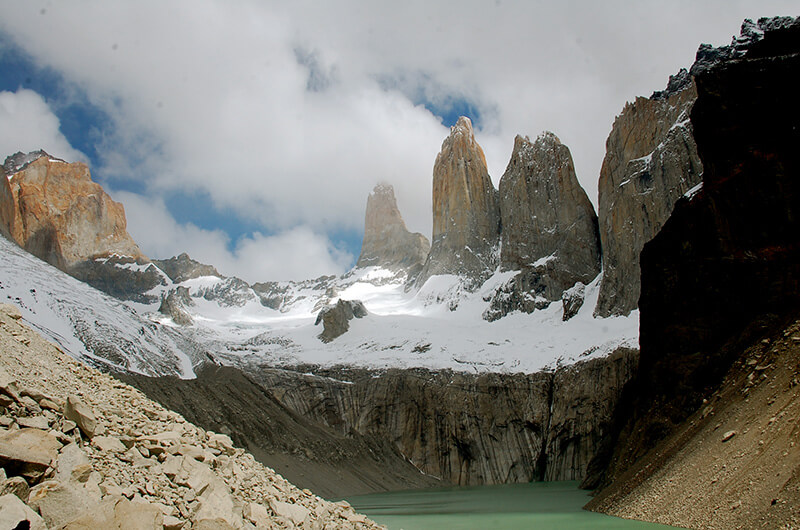
|
|
A view of The Towers
in Paine National Park in the Patagonian region of Chile.
|
Having watched breathtaking photographs and documentaries of Patagonia numerous times, these were the images that stayed with me and brought this “uttermost part of the earth” to the top of my must-see list this winter: the pink granite walls of Argentina’s Fitz Roy Massif basking in the early morning sun, the spectacular ice-blue wall of the Perito Moreno glacier and the roar of ice blocks falling in the lake beneath, and the impressive, nearly invincible towers of Chile’s Torres del Paine National Park. I had to see it for myself!
Why Choose Local Guides for Your Patagonian Adventure?
I had been tossing several ideas before finally making it happen. Traveling solo could be the cheapest solution, but I would need ample time to travel around and handle complicated connections between the various towns and parks. I could also fly directly to El Calafate and El Chaltén, and limit myself to the most exciting treks and excursions offered by local agencies, which are in abundance. However, I would have to miss out on many other worthwhile sights. Wanting to see as much as possible in a relatively short period and taking into account that for a solo traveler, trekking could be hazardous, I ended up choosing a third option: I booked an all-inclusive budget tour with a reliable agency in Buenos Aires, leaving logistics and fees in the hands of local entrepreneurs, and assuring myself of guides and company.
The Journey Starts in Argentina
I was welcomed at Calafate Airport and escorted to a shuttle that dropped me off at Hostal del Glacier Pioneros, our first night's accommodation. There, I was met by our tour leader and my eight trekking companions, hailing from England, Scotland, USA, and Brazil, varying in age from 25 to 65. To break the ice, they had organized a welcome dinner in one of the better restaurants in El Calafate, where we were invited to dig into generous platters of lamb and sip from an Argentinean wine. At the same time, our tour leader unfolded the plans for the two upcoming weeks. Our first destination would be El Chaltén, the gateway to the impressive Fitz Roy Massif and Cerro Torre in northern Argentina's Glaciers National Park. From there, we would slowly make our way southwards.
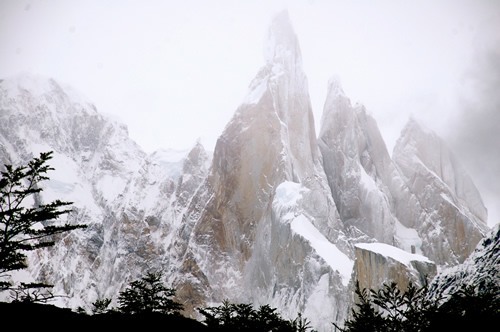
|
|
The Fitz Roy spires arer
finally visible.
|
Hiking Weather
We started hiking under perfect weather conditions along the gentle slopes of the Fitz Roy trail, passing various excellent viewpoints for watching the intriguing spires and vertical granite walls of these imposing mountains. This was Patagonia at its best! So confident had we already become about our good weather fortune that the sudden rain on days 3 and 4 hit us like a ton of bricks. Of course, we were all forewarned about the possibility of cold and windy days in Patagonia, and we knew how to dress in layers, from thermal underwear to gloves and woolen hats. But nothing had prepared us for a steady downpour that went straight through our backpacks and clothes. It totally blocked the view of what we had hoped to see: the Fitz Roy massif spires, Cerro Torre, and the Adela range.
Ups and Downs in the Mountains
Standing eye in eye with the giant Perito Moreno Glacier UNESCO World Heritage Site, set in Lake Argentino in the southern part of the Glaciers National Park at a 78 km distance from El Calafate, was an absolutely unforgettable experience, despite the crowds that such a wonder of Mother Nature inevitably attracts. There is a walking circuit with balconies to view this spectacular site, which is 4 km wide and towering more than 60 meters above the water's surface. We took a short boat ride in front of the south wall, where we watched and heard massive ice blocks calving off and crashing down into the water below. We also partook in a "mini-ice trek" with an experienced guide, hiking on the icy surface of the glacier with crampons attached to our boots and enjoying incredible close-ups of the many spectacular formations of the blue-hued Perito Moreno.
Staying a good sport in the face of
adversity clearly paid off, as the clouds started to open
up early next morning, and the white-powdered Fitz Roy spires
suddenly became visible through the lifting fog, peacefully
reflected in all their glory in the water of Laguna Torre
during our return trek to El Chaltén. Once back in
this small mountain town, the comfort of Pudu Lodge and
the excellent cordero asado in one of El Chaltén’s
many eateries felt like well-deserved rewards.
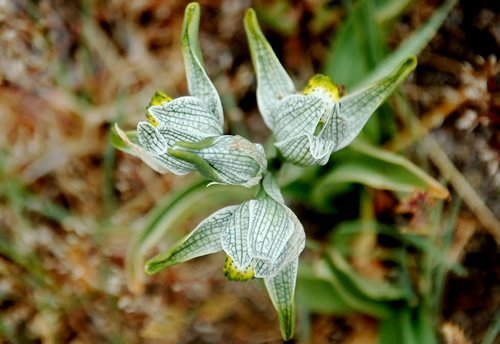
|
|
One of the 4 orchid
varieties around El Chalten.
|
Perito Moreno Glacier
Standing eye in eye with the giant Perito
Moreno Glacier, set in Lake Argentino in the southern part
of the Glaciers National Park at a 78 km distance from El
Calafate, was an absolutely unforgettable experience, in
spite of the crowds that such a wonder of Mother Nature
inevitably attracts. There is a walking circuit with balconies
to view this spectacular UNESCO World Heritage Site, 4 km
in width and towering more than 60 m. above the surface
of the water. We took a short boat ride in front of the
south wall where we watched and heard massive ice blocks
calving off and crashing down into the water below. We also
partook in a “mini-ice trek” with an experienced
guide, hiking on the icy surface of the glacier with crampons
attached to our boots, and enjoying incredible close-ups
of the many spectacular formations of the blue-hued Perito
Moreno.
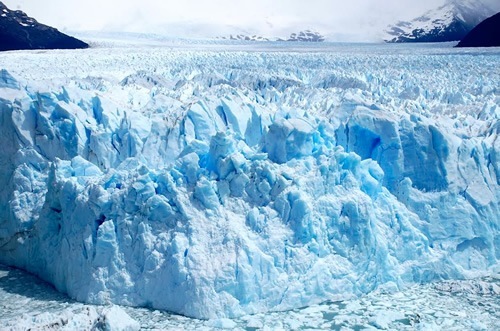
|
|
Perito Moreno
Glacier.
|
Chile's Spectacular Patagonian Sights
After crossing the border into Southern Chile, we headed for yet another UNESCO (Biosphere Reserve) Site: Torres
del Paine National Park. This park is home to world-famous mountains such as Paine Grande, the Horns, and the Towers, as well as lakes, rivers, glaciers, waterfalls, and rich wildlife, including guanacos, caracaras, condors, and vultures.
For another three nights, we lodged in full camps, this time with better toilet facilities than the basic latrine types of Argentinean camps and with dinners in comfortable lodges rather than in tents. Standing out was undoubtedly the trek from Estancia Cerro Paine via the Ascensio Valley to the Towers viewpoint. There, we found a glacier-originated lagoon of a milky-green color as a backdrop for the iconic Paine towers rising 1 km vertically from the glacier.
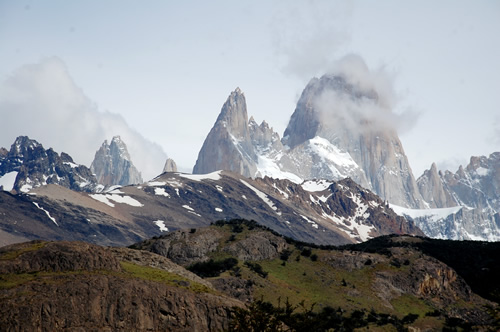
|
|
The Towers viewpoint in Paine National Park. |
Patagonia’s Other Face
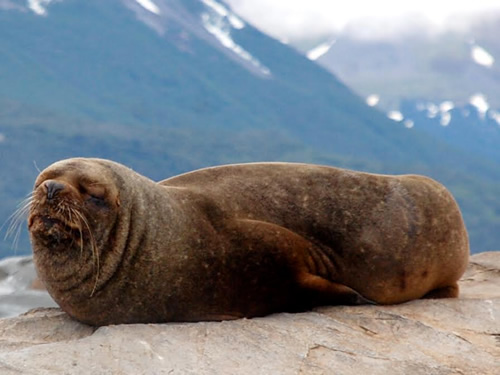
|
|
A sea lion relaxing
on a rocky ledge in Beagle Channel.
|
Patagonia is not only about mountains and trekking, however. Once we had boarded the ferry, crossing the legendary Magellan Strait toward Tierra del Fuego (literally: "land of fire," due to the fires of the local Indians for cooking and heating, noticed by early seafarers), a totally different landscape unfolded before our eyes: vast blue skies, sub-polar forests, and endless steppes with herds and herds of sheep. We stayed at one of the typical sheep ranches, took a boat ride through the Beagle Channel to watch colonies of walruses and cormorants, and enjoyed a memorable "King crab by the kilo" meal in Argentine Tierra del Fuego's capital Ushuaia — the southernmost city of the world and port for cruise and expedition ships to Antarctica — before heading back to Buenos Aires, Santiago de Chile, and beyond.
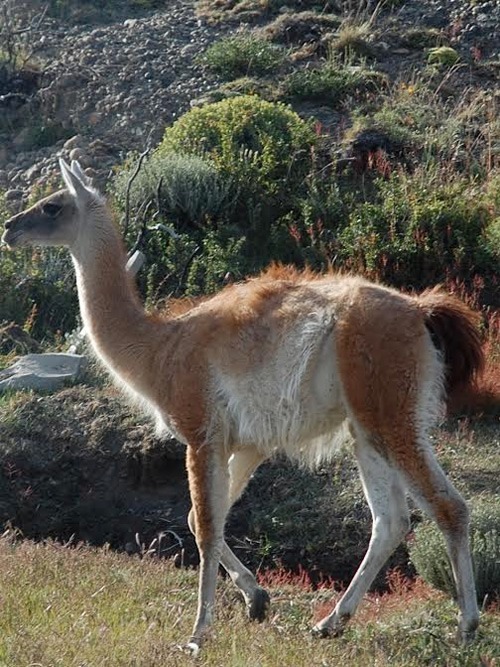
|
|
A guanaco strolling
in the hills of Patagonia.
|
For More Information on Patagonia Tours
-
The total cost for a 13-day tour with SAY HUEQUE, perfectly executed by knowledgeable, English-speaking guides, comes to US$3065, including shared accommodations (Inn and B&B), transport between all bases from El Calafate to Ushuaia, additional local guides on all treks and excursions, and practically all meals. Note: Tours and prices are subject to change.
-
For more info: For lodgings and excursions only visit Del Glaciar.
-
The best time for the outdoors
in Patagonia is from late October until early
March, when it is spring and summer in the southern
hemisphere. Be prepared for four-seasons weather
anyhow, as weather conditions vary and change
fast in Patagonia!
-
Hikes averaged 6-8 hours
a day and were all of moderate level — fitness
and good health being the most important requirements.
|
Lies
Ouwerkerk is originally from Amsterdam,
The Netherlands, and currently lives in Montreal,
Canada. Previously a columnist for The Sherbrooke
Record, she is presently a freelance writer and
photographer for various travel magazines.
|
